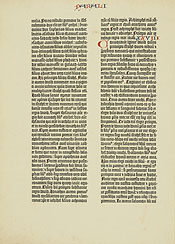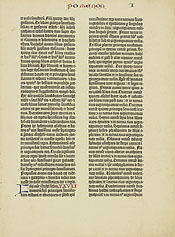Gutenberg’s Bible
![]()
This leaf, from the famous edition of the Latin Vulgate known as the Gutenberg
Bible, displays the first printer’s attempt to reproduce the look
of the medieval manuscript. The type is based on the Gothic minuscule
of the High Middle Ages and preserves the scribal abbreviations found
in manuscript books. An important difference, however, is that the impressions
are made on paper rather than parchment. This alternative writing surface
had been making headway for some time in Europe, but only with the advent
of the printing press did paper become the dominant writing surface.
![]()
Vulgate Bible. Printed by Johan Gutenberg. Germany,
1450–1455.
![]()

Copyright
© 2002 Division of Rare & Manuscript
Collections
2B Carl A. Kroch Library, Cornell University, Ithaca, NY, 14853
Phone Number: (607) 255-3530. Fax Number: (607) 255-9524
For
reference questions, send mail to:
rareref@cornell.edu
If you have questions or comments about the site, send mail to: webmaster.

